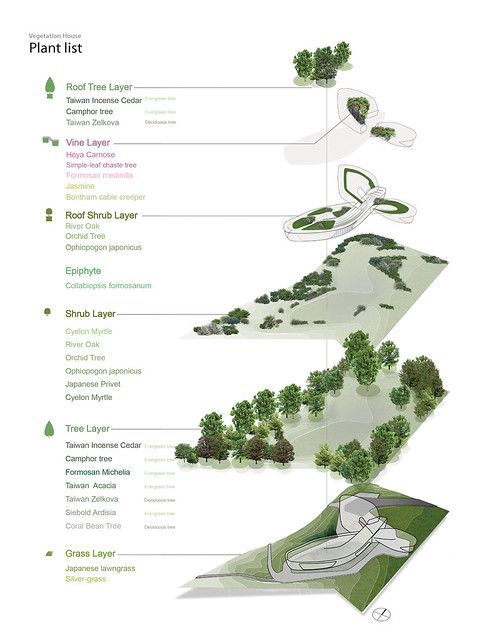建築是否能與多種不同性質的植物和諧共生?交通大學建築所碩士李政儒和胡介璿兩人共同發想的「植生住宅」計畫,以住宅與自然景觀融為一體的概念進行設計, 這項設計自全世界四五○多件競賽作品中脫穎而出,獲得美國景觀設計師協會(American Society of Landscape Architects, ASLA)舉辦的國際競圖學生競賽住宅設計首獎!證明「台灣小子」的身手的確不凡。
ASLA 美國景觀設計師協會成立於一八九九年,是一個世界性的專業協會,提供美國景觀專業者認證,也是全球最有影響力的景觀設計專業協會,每年舉辦專業獎及學生獎 兩組國際競賽。交大建築所所長龔書章表示,2011年九9月17日公佈首獎,這是台灣歷年參加這項國際競圖獲得的最高榮譽,與賓州大學、哈佛設計學院、加 州大學柏克萊分校等歐美名校並駕齊驅。
而交大與另一獲得佳作的上海同濟大學,是今年「唯二」的亞洲面孔,龔書章說「我認為這對台灣建築系學生目前徬徨而低迷的學習氛圍,在士氣與鬥志上是莫大的鼓舞。」
廿五歲的李政儒與廿六歲的胡介璿,2011年甫從交大建築所碩士班畢業。有鑑於台灣一日生活圈的形成,他們觀察到不少都市人口假日往郊區移動的趨勢,但如何在容納都市人口的同時又能兼顧原有的自然景觀?成了兩人「植生住宅」設計的發想來源。
李政儒說:「好比一顆坐落在樹林中的石頭,植物順應當地環境附著於其上,不會對原本的生態系進行改變與破壞,又能和諧融入生態當中。」
兩 人以新北市貢寮鄉的澳底作為想像的基地,分析當地原生植栽生態,加入季風、濕度、雨水等自然因子,設計出宛如一艘船形的住宅外觀。他們並依不同植物的生長 特性,使其分佈在住宅四周,以保有生態多樣性,例如開闊的屋頂中央設計柱形的空心結構,提供深根性植物充足的陽光以及厚實土壤、充足水分等生長空間;戶外 半日照處可供攀藤類植物生長;建築立面設計有灌溉系統的植生磚,可以讓蕨類植物、苔蘚植物依附生長。
李政儒表示,「我們考慮建築是否能創造出適合多種不同性質的植物成長的環境,讓多種植物從戶外蔓延到建築體的各個角落,產生自然多樣性,讓我們像是生活在豐富的大自然之中。」
相關網頁
::ASLA Announces 2011 Student Awards::
交通大學建築所碩士李政儒和胡介璿兩人共同發想的「植生住宅」計畫(繼續往下看,有設計案圖片)。
Award of Excellence
Vegetation House: House for Being the Medium of Plant Growth
Jheng-Ru Li, Student Affiliate ASLA and Chieh-Hsuan Hu, Student Affiliate ASLA, Graduate, National Chiao Tung University
指導老師:Yu-Tung Liu 劉育東, Yuan-Rong Li 李元榮, Shiau-Yun Lu and Chor-Kheng Lim
Project Statement
Concerning the problem of farmhouses in the suburban areas.This project is aimed to focus on whether the building creates a suitable environment for many different types of plants to grow naturally. Just as a stone in the forest is attached to a plant by the local environment, the building should not change or, worse, destroy the original ecosystem; it should coexist in harmony with the ecosystem and allow a diversity of plants to grow smoothly alongside it.
Project Narrative
Context
Because Taiwan participates in the WTO, the government helps to change the usage of excessive farmlands in order to raise the competitiveness of local agriculture. The government promotes the construction plans of farmhouses, which improves both farmers’ quality of life and the environment for the production process. In recent years, due to the convenience of transportation, people from metropolises have had greater willingness to travel to suburban areas for vacation. Some reasons for this are that people want to get away from the crowded and noisy cities and be closer to Mother Nature. Such interest in suburban areas increases tourists’ assets, and that means it improves the economic situation there, giving rise to the problem that too many new buildings occupy the territory, and nature disappears. Therefore, the objective of this project is to use these imperative requirements — locating in a suburban location near a metropolis, close to nationally protected forest areas, and developing the region now — to be the basis of choosing this proposed project site.
Site Analysis & Current Situation
Aodi is located in northeast Taiwan, in Gong-Liao Township in Taipei. The easternmost Administrative Region of Taiwan faces the Pacific Ocean on the east. With a warm and moist climate. The location is affected by the monsoon climate, heavy annual rain.
In 2008, the well-known construction company launched the project during which the company invited 20 international architects to design creative farmhouses in the land close to Snow Mountain, which is a nationally protected forest area. If the farmhouse’s construction plan proceeds without environmental awareness, it will lead to an enormous environmental impact.
Design Program and Intent
Based on the existing conditions, several strategies are proposed in this project to deal with the balance between biodiversity and the living environment.
Create the Diversity of Vegetation: Diversity is based on the plant analysis diagram, from the existing plants on the site and native plants in Taiwan. According to different environmental factors, it is suitable for the growth of plants, to configure the distribution areas of the plant and to design the buildings’ forms.
Deep-rooted plants: A configuration of deep-rooted plants at the center of the roof will provide sufficient sun and the growth of space, using a hollow cylindrical structure that will connect the land to provide thick soil and enough water for the deep-rooted plants.
Climbing plants: A climbing rattan plant growth environment requires a thinner soil layer, high sensitivity to humidity, and low sunshine duration. By dislocating them between the height of the building floors and the external high-ceilinged space, we will create a half-sunshine space, to provide a cool and humid environment to climbing plants.
Shrub plants: The ability of different species of shrubs plants to adapt for soil thickness, humidity, sunshine duration, and growth factors is broader, using an outdoor balcony on the second floor to disperse the growth locations. To achieve several different species of shrub plants scattered throughout the outdoor balcony, soil is evenly distributed in this project and restrict its thickness and size, as the sunshine duration and soil conditions are different.
Epiphyte plants: Regarding ferns and bryophytes, species of epiphyte plants on the building’s facade, the planters are designed with brick from the irrigation systems, so that seeds will attach to the vertical building facade naturally.
Improve monsoon winds: Aodi is under the strong northeast monsoon winds in the winter. In order to reduce the effect of monsoons on the circulation in the north building, windbreaks are planted in the north to block these gusts. Heightening the northeast facade will also reduce the strength of the northeast monsoon winds throughout the overall environment.
Control humidity: The contact of climbing plants with soil is less than with other plants, so they need to be moistened by the air to survive. If the humidity of the environment becomes too low, climbing plants can easily dry and wither. The humidity and temperature will be maintained and adjusted to avoid having the climbing plants touch the high-temperature wall during daylight hours.
Recycle and reuse rainwater: On the site, there is a long, rainy winter and heavy, instantaneous rainfall in the summer. The hillside terrain leads to rapid loss of rainwater, and the soil is also not good at retaining water. The lowest location of the ecologically poor site is selected to collect and keep the local rainwater. This adjustment will contribute to controlling the microclimate of the surroundings of the building and make the ecological environment less susceptible to dramatic variations in the climate.
New tectonics: By using computer-aided design and computer-aided manufacturing , a structure different from the traditional vertical and horizontal system structure will be able to manufactured in this project. In order to reduce the construction time on the land and to avoid waste, the construction will remain limited to the local environment. In this proposed design, most component will be produced and processed completely in factories and then transported to the site to be assembled.
This approach can achieve peaceful coexistence between the building and the environment, under the premise of not destroying the land to build a farmhouse and maintaining the local ecosystem in this National Scenic Area, using means such as stones covered with plants, which, although existing, will not be awkward.

李政儒+胡介璿 – 植生住宅 Vegetation House 01

李政儒+胡介璿 – 植生住宅 Vegetation House 02
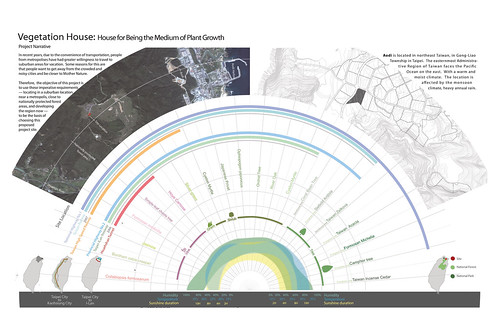
李政儒+胡介璿 – 植生住宅 Vegetation House 03
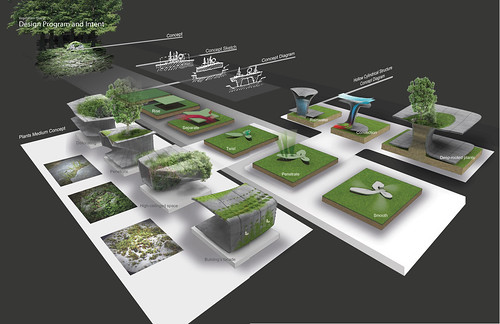
李政儒+胡介璿 – 植生住宅 Vegetation House 04
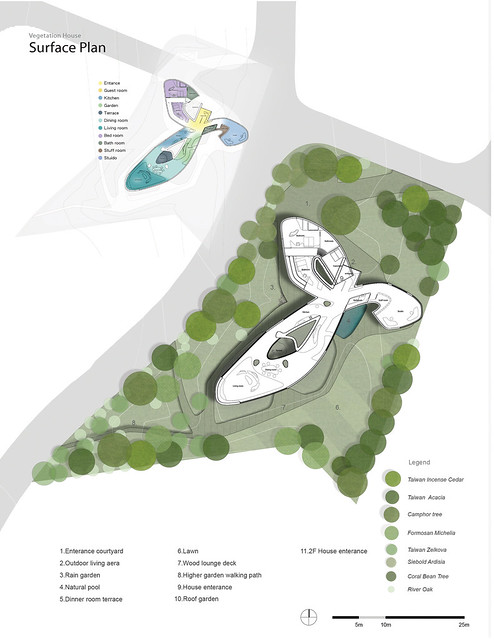
李政儒+胡介璿 – 植生住宅 Vegetation House 05
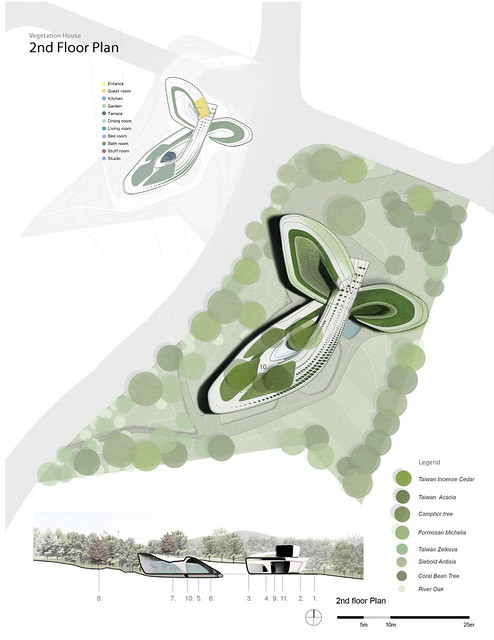
李政儒+胡介璿 – 植生住宅 Vegetation House 06
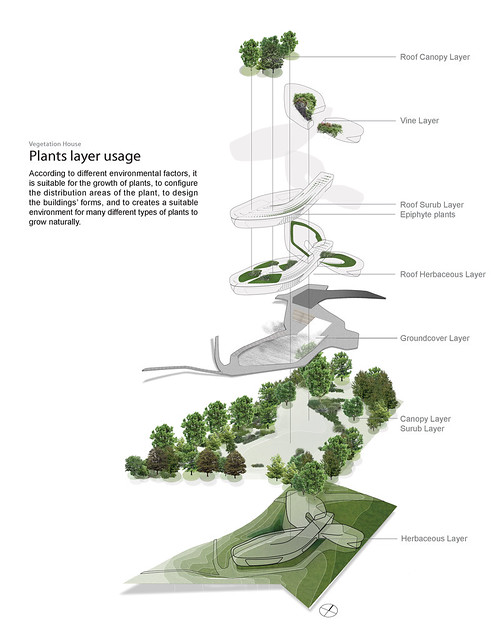
李政儒+胡介璿 – 植生住宅 Vegetation House 07

李政儒+胡介璿 – 植生住宅 Vegetation House 08

李政儒+胡介璿 – 植生住宅 Vegetation House 09
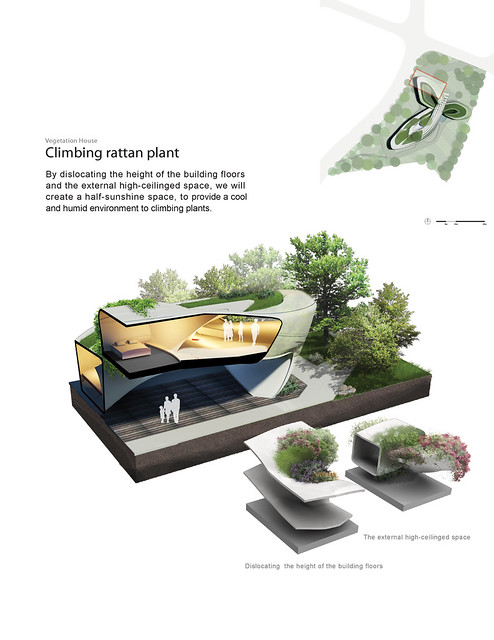
李政儒+胡介璿 – 植生住宅 Vegetation House 10
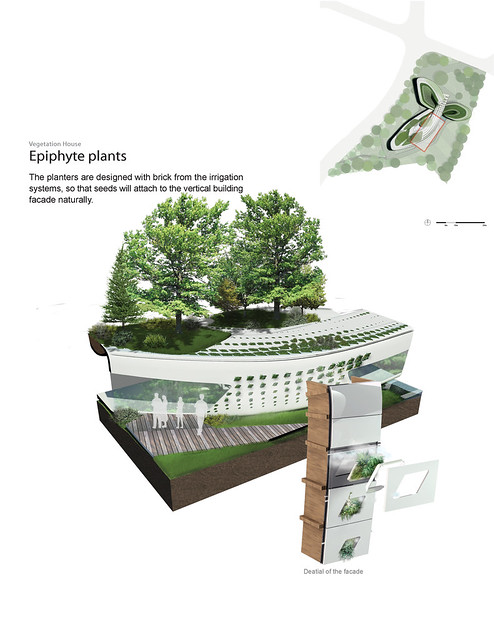
李政儒+胡介璿 – 植生住宅 Vegetation House 11

李政儒+胡介璿 – 植生住宅 Vegetation House 12
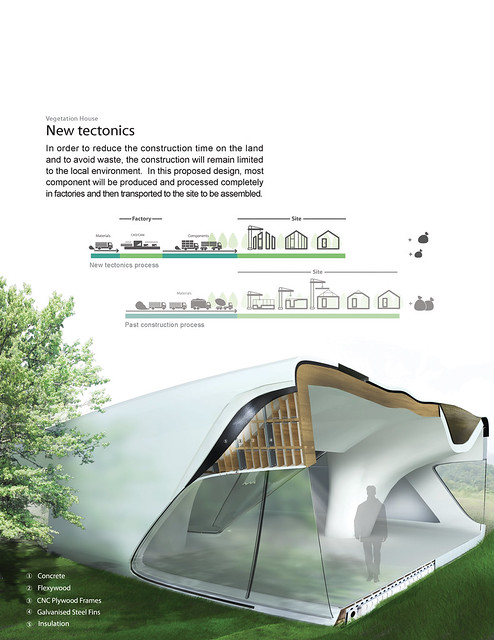
李政儒+胡介璿 – 植生住宅 Vegetation House 13

李政儒+胡介璿 – 植生住宅 Vegetation House 14
ASLA 頁面:http://www.asla.org/2011studentawards/558.html


